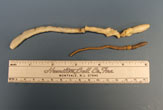Rare 3-Foot Spitting Earthworm Found in Legal Battle

A rare 3-foot-long spitting earthworm that smells like lilies is at the heart of a legal battle between conservationists and the U.S. government.
When taxonomist Frank Smith discovered the giant Palouse earthworm (Driloleirus americanus) in 1897 by, he described it as "very abundant." Nowadays, however, sightings of the worm are rare.
The only recent confirmed worm sighting was made in 2005 by a University of Idaho researcher. Before that, the giant worm had not been spotted in 17 years, since 1988.
It reportedly grows up to three feet long and has a peculiar flowery smell (Driloleirus is Latin for "lily-like worm"). The cream-colored or pinkish-white worm lived in permanent burrows as deep as 15 feet and spat at attackers.
"This worm is the stuff that legends and fairy tales are made of. A pity we're losing it," said Steve Paulson, a board member of Friends of the Clearwater, a conservation group based in Moscow, Idaho.
Unlike the European earthworms now common across the United States, the giant Palouse earthworm is native to the Americas. Specifically, the giant worm dwelled in the prairies of the Palouse, the area of the northwest United States. The Palouse has been dramatically altered by farming practices, the U.S. Fish and Wildlife Service noted.
"The giant Palouse earthworm is extremely rare and faces substantial risk of extinction," said Noah Greenwald, a conservation biologist with the Center for Biological Diversity, a conservation group based in Tucson, Ariz.
Get the world’s most fascinating discoveries delivered straight to your inbox.
Conservation groups had petitioned the U.S. Fish and Wildlife Service in 2006 to protect the worm as an endangered species. The World Conservation Union currently ranks the worm as "vulnerable" — one step away from "endangered" in terms of conservation status.
Last October, the U.S. Fish and Wildlife Service decided the worm did not warrant protection as an endangered species. Still, "we share the petitioners' concern for the species," said Susan Martin, supervisor for the Upper Columbia Fish and Wildlife Office in Spokane, Washington, in a press release.
"They do seem to be rare, but rarity doesn't mean endangered," U.S. Fish and Wildlife spokesperson Tom Buckley told LiveScience. "They may be in trouble, but we'd need more information to know, and based on the information we received, there's not enough scientific data out there to make a determination."
Greenwald countered, saying, "Rarity is certainly a factor in species endangerment. It's possible to have a species that is rare but not endangered, that only occurred naturally in one or two places, with those places being entirely secure, but that is not at all the case here with the giant Palouse earthworm. Its presumed habitat is almost gone — something like 3 percent of the native Palouse prairies is left."
Now conservation groups have filed suit to overturn the U.S. Fish and Wildlife Service's decision with the U.S. District Court for the Eastern District of Washington. "The earthworm needs the protection of the Endangered Species Act to survive," Paulson said.
The conservation groups note that in seeking protection for the worm, they are also hoping to defend the prairies of the Palouse.
"In order to protect endangered species, you have to protect the places in which they live," Greenwald told LiveScience. "In seeking to protect the earthworm, we want to protect those remnants of the Palouse prairie that still exist."
- Why Does Rain Bring a Flood of Earthworms?
- Image Gallery: Backyard Bugs
- Secret Insect Weapons

 Live Science Plus
Live Science Plus





